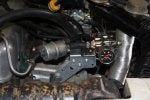The more I get into this install the less I like the Carb.
Their technical support is not very helpful.
The current problem I am having is the return spring. In step 14 they state Connect the original throttle return spring to the bracket and the lower lever on the Weber carburetor.
If I do that the spring just hangs there limply.
I went through Keith460 build and noticed that he put the spring on the linkage rod form the carburetor to the stock cable bracket. I tried that and it still does not return the carburetor to idle.
This is a new out of the box Weber. The throttle linkage on the carburetor with nothing attached seems stiff to me, not binding but takes more effort than I would expect (compared to a Holley).
Technical support says go to an auto parts store and buy more springs.
What do you say?
In the directions they talk about over tightening the throttle shaft nut. This was installed at the factory. There is visible play of the throttle shaft lever; I do not believe the nut was over tightened. I did lightly tap on the end of the shaft to “re-centralize” the throttle plate.
Based on all the posts I’m seeing on Weber carburetors they seem to be very finicky and touchy and require a lot of set up
Their technical support is not very helpful.
The current problem I am having is the return spring. In step 14 they state Connect the original throttle return spring to the bracket and the lower lever on the Weber carburetor.
If I do that the spring just hangs there limply.
I went through Keith460 build and noticed that he put the spring on the linkage rod form the carburetor to the stock cable bracket. I tried that and it still does not return the carburetor to idle.
This is a new out of the box Weber. The throttle linkage on the carburetor with nothing attached seems stiff to me, not binding but takes more effort than I would expect (compared to a Holley).
Technical support says go to an auto parts store and buy more springs.
What do you say?
In the directions they talk about over tightening the throttle shaft nut. This was installed at the factory. There is visible play of the throttle shaft lever; I do not believe the nut was over tightened. I did lightly tap on the end of the shaft to “re-centralize” the throttle plate.
Based on all the posts I’m seeing on Weber carburetors they seem to be very finicky and touchy and require a lot of set up






































